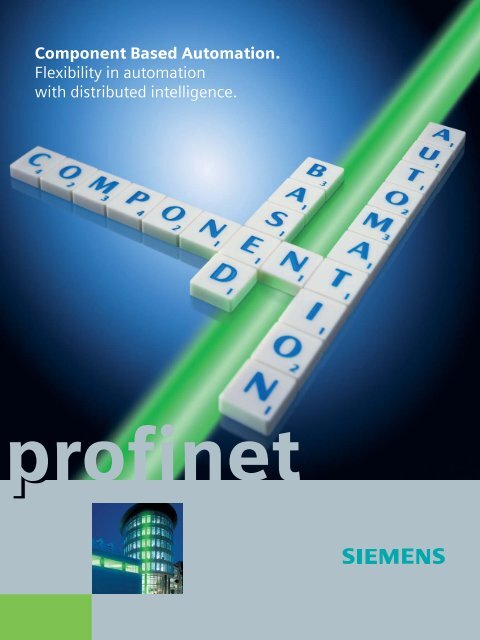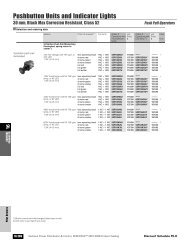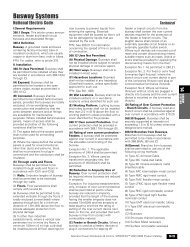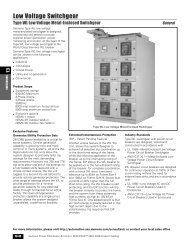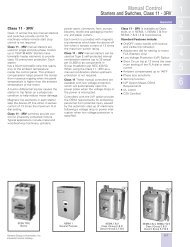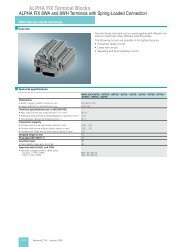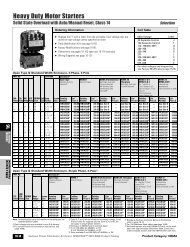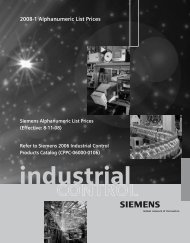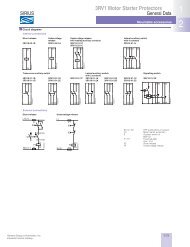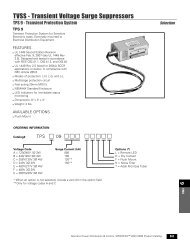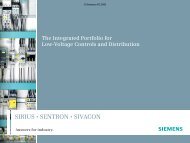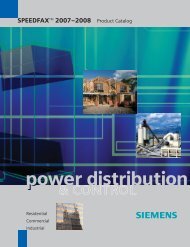Component Based Automation. Flexibility in automation ... - Siemens
Component Based Automation. Flexibility in automation ... - Siemens
Component Based Automation. Flexibility in automation ... - Siemens
You also want an ePaper? Increase the reach of your titles
YUMPU automatically turns print PDFs into web optimized ePapers that Google loves.
Communication between mach<strong>in</strong>es:Configur<strong>in</strong>g <strong>in</strong>stead of programm<strong>in</strong>gThe commission<strong>in</strong>g time needed for a mach<strong>in</strong>e <strong>in</strong> a productionl<strong>in</strong>e is determ<strong>in</strong>ed to a very large degree by the programm<strong>in</strong>gof communication l<strong>in</strong>ks to other plant sections. Suchprogramm<strong>in</strong>g costs time, can be very expensive, particularly<strong>in</strong> the case of mach<strong>in</strong>es with different <strong>automation</strong> systems,and can often not be precisely planned. S<strong>in</strong>ce itis necessary to <strong>in</strong>tervene <strong>in</strong> the user program, the operatoris normally unable to grant f<strong>in</strong>al acceptance untilthe mach<strong>in</strong>e is networked. Subsequent problems result <strong>in</strong>further delays.<strong>Component</strong> <strong>Based</strong> <strong>Automation</strong> encapsulates the userprogram, completely separat<strong>in</strong>g the programm<strong>in</strong>g of amach<strong>in</strong>e from the configur<strong>in</strong>g of the communication l<strong>in</strong>ksto achieve a significant reduction <strong>in</strong> the commission<strong>in</strong>gtime.The advantages at a glance:• Thanks to the encapsulation of the user program, theprogram need no longer be modified when the communicationl<strong>in</strong>ks are configured.• The mach<strong>in</strong>e can be accepted prior to commission<strong>in</strong>gof the plant. Improvements can be made by the mach<strong>in</strong>ebuilder – without the time pressure of commission<strong>in</strong>g.• Simple graphical configuration of the communicationl<strong>in</strong>ks replaces time-consum<strong>in</strong>g expensive programm<strong>in</strong>g,and significantly reduces commission<strong>in</strong>g overheads forthe plant operator.• The creation and re-use of standardized componentssaves time and <strong>in</strong>creases quality thanks to systematicma<strong>in</strong>tenance of re-usable software functions.• Improved diagnostic functionality enables unambiguouserror allocation dur<strong>in</strong>g operation.5
SIMATIC iMap V3.0:Easy to use with numerous functionsFor <strong>Component</strong> <strong>Based</strong> <strong>Automation</strong> and configuration ofmach<strong>in</strong>e-mach<strong>in</strong>e communication, the current Version V3.0of SIMATIC iMap <strong>in</strong>corporates a series of new functions. Forexample, the new “Plan View” of a plant enables transparentnavigation <strong>in</strong> large-scale projects and a simple method ofstructur<strong>in</strong>g thanks to plan-<strong>in</strong>-plan displays. This makes itvery easy to copy whole parts of a plant, thus considerablyaccelerat<strong>in</strong>g the entire process of eng<strong>in</strong>eer<strong>in</strong>g.A real highlight of SIMATIC iMap V3.0 comes <strong>in</strong> the formof several technological functions which can be mappedon a device – at the present time, on devices based on theCPU 319-3 PN/DP as well as modules with PROFINET CBARuntime V2.2. This enables f<strong>in</strong>er granularity and thus bettertechnological structur<strong>in</strong>g of the application <strong>in</strong> question. Inrespect of flexibility of use, the current version of the triedand-testedeng<strong>in</strong>eer<strong>in</strong>g tool has been optimized as well <strong>in</strong>that users can now activate and deactivate <strong>in</strong>dividual functions.It is therefore possible to check the functions of a component<strong>in</strong> <strong>in</strong>dividual steps and start up the component <strong>in</strong> a flexiblemanner. Other advantages are created by the various languages<strong>in</strong> which the new version is available: not only English andGerman but also Italian, French and Spanish as well.Plant viewNetwork view9
Advantages at a glance• Several technological functions <strong>in</strong> one device – basedon the CPU 319-3 PN/DP as well as modules withPROFINET CBA Runtime V2.2• Simpler structur<strong>in</strong>g through plan-<strong>in</strong>-plan display• Shorter eng<strong>in</strong>eer<strong>in</strong>g time through copy<strong>in</strong>g of whole plantsections• Faster program downloads through download via list• Simple diagnostics through mark<strong>in</strong>g of critical signals• Improved general overview as connections can be displayedor concealed as required• Only altered data are loaded <strong>in</strong>to the CPU <strong>in</strong> order to reta<strong>in</strong>process data that has already been acquired• Simplified load<strong>in</strong>g of several CPUs – without pop-up dialogs• Improved project documentation <strong>in</strong> HTML format• Optimized pr<strong>in</strong>t<strong>in</strong>g function for project data, <strong>in</strong>clud<strong>in</strong>gcross-references• Command <strong>in</strong>terface for higher-level CAD tool landscapeProject view10
Graphical <strong>in</strong>terconnection of PROFINET components:Significantly reduce overhead with SIMATIC iMapIn SIMATIC iMap, communication l<strong>in</strong>ks between <strong>in</strong>telligentmodules are configured by graphically <strong>in</strong>terconnect<strong>in</strong>g themodules’ technological <strong>in</strong>terfaces. This is done by simplydraw<strong>in</strong>g l<strong>in</strong>es between the technological <strong>in</strong>terfaces.The user works only with technological terms such as”Enable to next station“, “Start”, “Stop”, “Manual Operation”,“Buffer Overflow”, and so on.The technological terms are established by the plant ormach<strong>in</strong>e builder when he def<strong>in</strong>es the component <strong>in</strong>terface<strong>in</strong> STEP 7.Communication between the components is also put <strong>in</strong>tooperation and tested with SIMATIC iMap us<strong>in</strong>g onl<strong>in</strong>e functionsand diagnostic options <strong>in</strong>tegrated specifically for thispurpose.Follow<strong>in</strong>g the download, the communication l<strong>in</strong>k is establishedand the relevant devices exchange data.The lack of a need for <strong>in</strong>tervention <strong>in</strong> the user programsof the <strong>in</strong>dividual mach<strong>in</strong>es dur<strong>in</strong>g plant commission<strong>in</strong>gtotally precludes undesired <strong>in</strong>teraction with the pre-testedfunctions.Onl<strong>in</strong>e diagnosticsAt the <strong>in</strong>terfaces of the relevant software functions, thestatus of the selected signals can be displayed and controlledthrough well-directed test values. The diagnostic w<strong>in</strong>dowshows the status of the devices. In the event of an error,the configur<strong>in</strong>g eng<strong>in</strong>eer, us<strong>in</strong>g the detailed <strong>in</strong>formationdisplayed (e.g. ”Device not available, check physical connection“),can quickly localize and elim<strong>in</strong>ate possible communicationproblems. Follow<strong>in</strong>g error recovery, specific iconssignal that data <strong>in</strong>terchange between the devices is onceaga<strong>in</strong> problem-free.Characteristic features of SIMATIC iMap:• Builds on the open and component-basedarchitecture of PROFINET.• Each mach<strong>in</strong>e/plant module is represented <strong>in</strong>the configuration editor by a “PROFINETcomponent”. This component, <strong>in</strong> turn, is represented<strong>in</strong> the form of a software function and an associated<strong>in</strong>telligent device.• Interconnects technology-oriented library elements<strong>in</strong>dependent of their orig<strong>in</strong> and functionality.• Onl<strong>in</strong>e functions and diagnostic options for thecommunication functions simplify commission<strong>in</strong>g.• PROFINET components can be designed for moremultiple usage <strong>in</strong> SIMATIC iMap (re-use of libraryelements) or as so-called s<strong>in</strong>gletons for one-timeuse only. The central modifiability of multiple-usecomponents saves on eng<strong>in</strong>eer<strong>in</strong>g overheads.• Sub-configurations allow the mach<strong>in</strong>e/plant to behierarchically structured to virtually any depth.• All variables required for general data access,such as visualization, access at the MES level etc.(OPC tag file), are automatically generated fromthe eng<strong>in</strong>eer<strong>in</strong>g <strong>in</strong>formation.For SIMATIC devices it is possible to execute expandeddiagnostics which go significantly beyond the standarddef<strong>in</strong>ed by PROFINET. It is then also possible to navigate <strong>in</strong>STEP 7 itself. The diagnostic options <strong>in</strong> STEP 7 can be usedto their full extent.11
Distributed <strong>in</strong>telligence: Flexible use is paramountIn many production plants, distributed <strong>automation</strong> solutionsare already reality. <strong>Component</strong> <strong>Based</strong> <strong>Automation</strong>simplifies the configuration of the communication between<strong>in</strong>telligent modules l<strong>in</strong>ked to one another and over PROFINET.These modules can be components <strong>in</strong> a production l<strong>in</strong>e orrepresent <strong>in</strong>dividual mach<strong>in</strong>es and – <strong>in</strong> addition to thecontroller – may conta<strong>in</strong> lower-order field bus systems aswell as <strong>in</strong>telligent I/Os on the PROFIBUS.Data <strong>in</strong>terchange between modules on the PROFINET andthose on the PROFIBUS is subject to virtually no restrictions.PROFINET devices on the Ethernet can communicatewith one another as well as with <strong>in</strong>telligent slaves on thePROFIBUS. The visualization of PROFINET components ispossible via the SIMATIC NET PN OPC server. Variables ofPROFINET devices connected to the PROFINET via a proxyrather than directly may also be accessed.12
Integration of distributed I/Os with<strong>Component</strong> <strong>Based</strong> <strong>Automation</strong>Intelligent I/O devices are atta<strong>in</strong><strong>in</strong>g <strong>in</strong>creased significance.<strong>Component</strong> <strong>Based</strong> <strong>Automation</strong> provides different optionsfor <strong>in</strong>tegrat<strong>in</strong>g these devices. The configuration below,from left to right, shows the follow<strong>in</strong>g examples:• As standard slave with<strong>in</strong> a PROFINET component,<strong>in</strong>tegrated <strong>in</strong> the program for the PROFINET device. Inthis case, the PROFINET devices are not displayed <strong>in</strong>SIMATIC iMap. They are part of the master’s component.• As PROFINET I/O device assigned to a PROFINET I/Ocontroller. I/O devices are part of the component of thePN I/O controller, and are not displayed as <strong>in</strong>dependentcomponents <strong>in</strong> SIMATIC iMap.• Interfaced as PROFINET component via a PROFINET proxy.The proxy is a PROFINET node on the Ethernet and –at the same time – the DP master for the devices on thePROFIBUS. Intelligent PROFIBUS devices or standard slaves<strong>in</strong>terfaced via a proxy are displayed as <strong>in</strong>dependentcomponents <strong>in</strong> SIMATIC iMap.Comb<strong>in</strong>ation of central and distributed <strong>in</strong>telligencewith <strong>Component</strong> <strong>Based</strong> <strong>Automation</strong>Plant sections with centralized <strong>in</strong>telligence and those withdistributed <strong>in</strong>telligence do not <strong>in</strong>fluence one another, butrather complement each other optimally with <strong>Component</strong><strong>Based</strong> <strong>Automation</strong>.The entire PROFIBUS segment of a centrally structured plantsection, <strong>in</strong>clud<strong>in</strong>g the master, forms a s<strong>in</strong>gle PROFINETcomponent (a so-called “s<strong>in</strong>gleton”). The PROFIBUS mastermust be expanded to <strong>in</strong>clude an Ethernet <strong>in</strong>terface modulewhich complies with the PROFINET Standard.S7-300 S7-300Eng<strong>in</strong>eer<strong>in</strong>gHMI...Eng<strong>in</strong>eer<strong>in</strong>gSIMATIC iMapSTEP 7VisualizationOPC serverDistributed <strong>in</strong>telligenceET 200M Field device MicromasterPlant section with centralized <strong>in</strong>telligenceS7-300 ProxyPN I/O-controller PN I/O-devicePlant sections with centralized <strong>in</strong>telligence can be <strong>in</strong>tegrated without modification<strong>in</strong> <strong>Component</strong> <strong>Based</strong> <strong>Automation</strong>. They are configured as a s<strong>in</strong>glePROFINET component with SIMATIC iMap.ET 200Mstandard slaveET 200MET 200SMicromasterFor every task a suitable solution: <strong>Component</strong> <strong>Based</strong> <strong>Automation</strong> supportsdistributed <strong>in</strong>telligence on PROFINET and PROFIBUS.13
Products for <strong>Component</strong> <strong>Based</strong> <strong>Automation</strong>Configuration editorSIMATIC iMapSIMATIC iMap is a component-based eng<strong>in</strong>eer<strong>in</strong>g tool for configur<strong>in</strong>g communicationl<strong>in</strong>ks <strong>in</strong> distributed <strong>automation</strong> solutions. It is used for the simple graphical configurationof the communication l<strong>in</strong>ks between plant modules and the communication l<strong>in</strong>ksbetween mach<strong>in</strong>es <strong>in</strong> a production l<strong>in</strong>e. It significantly reduces the user’s eng<strong>in</strong>eer<strong>in</strong>goverheads.Visualization via OPCPN CBA OPC serverThe PN CBA OPC server provides the PC application <strong>in</strong>terface for communication betweenthe visualization system and the PROFINET components over Industrial Ethernet.Devices for PROFINET with proxy functionSIMATIC W<strong>in</strong>AC software PLCWith the PROFINET option, the SIMATIC W<strong>in</strong>AC base can be used as a PROFINET componentfor <strong>Component</strong> <strong>Based</strong> <strong>Automation</strong>. The W<strong>in</strong>AC base thus supports data <strong>in</strong>terchangewith other PROFINET components over Industrial Ethernet.IE/PB L<strong>in</strong>kThe IE/PB L<strong>in</strong>k makes it possible to <strong>in</strong>terface PROFIBUS devices to Industrial Ethernet,thus mak<strong>in</strong>g it possible for these devices to be configured as PROFINET components.SIMATIC S7-300The SIMATIC S7-300 is available with CPU 319-3 PN/DP and CPU 317-2 PN/DP for the upperperformance range and CPU 315-2 PN/DP for the medium performance range with <strong>in</strong>tegratedPROFINET <strong>in</strong>terface. These CPUs have a comb<strong>in</strong>ation PROFIBUS DP/MPI <strong>in</strong>terface and anIndustrial Ethernet/PROFINET <strong>in</strong>terface. The central process<strong>in</strong>g units can also be operatedas an I/O controller for field devices on the PROFINET.14
Devices for PROFINET without proxy functionSIMATIC NET CP 343-1 and SIMATIC NET CP 443-1 AdvancedCommunications processors are available for <strong>in</strong>terfac<strong>in</strong>g SIMATIC S7 to the PROFINET. TheSIMATIC NET CP 343-1 is the communications module for Industrial Ethernet used to <strong>in</strong>tegratethe SIMATIC S7-300 <strong>in</strong> a <strong>Component</strong> <strong>Based</strong> <strong>Automation</strong> application or to directly operatefield devices on the PROFINET as an I/O controller. The SIMATIC NET CP 443-1 Advancedmakes it possible to <strong>in</strong>tegrate SIMATIC S7-400 controllers <strong>in</strong> PROFINET applications.Intelligent slaves for PROFIBUSSIMATIC ET 200S with IM 151-7 CPUThe IM 151-7 CPU of the ET 200S can serve both as stand-alone and for distributed <strong>automation</strong>solutions with medium-sized programs. It is equivalent to a CPU 314, and enablesdistributed local preprocess<strong>in</strong>g of production data <strong>in</strong> both standard and fail-safe versions.It communicates with the higher-order controller over the MPI/PROFIBUS DP slave <strong>in</strong>terface.SIMATIC S7-300All SIMATIC S7-300 CPUs which can be operated as slaves on the PROFIBUS.Standard slaves for PROFIBUSAll standard slaves with a GSD file which comply with the PROFIBUS DP standard.Depend<strong>in</strong>g on the application, PROFIBUS DP standard slaves with a GSD file can either bedisplayed as own PROFINET component <strong>in</strong> the configuration editor (e.g. POSMO A, SIMOCODE)or be assigned to the PROFIBUS master (e.g. ET 200M; are treated like central I/Os).All converters and motor starters which are standard slaves on PROFIBUS DP and have a GSDfile or are <strong>in</strong>tegrated <strong>in</strong> the ET 200 I/O system.15
<strong>Component</strong> <strong>Based</strong> <strong>Automation</strong> at workUnilever <strong>in</strong>creases the productivity of bottl<strong>in</strong>g andpackag<strong>in</strong>g l<strong>in</strong>esFast-chang<strong>in</strong>g production l<strong>in</strong>es <strong>in</strong> the consumer goods <strong>in</strong>dustryplace high demands on packag<strong>in</strong>g plants, which mustbe capable of be<strong>in</strong>g adapted quickly and economically todifferent shapes, sizes and materials. In order to ensurethis, one of the world’s biggest manufacturers of consumergoods depends on <strong>Component</strong> <strong>Based</strong> <strong>Automation</strong>. CBA makesit possible to encapsulate the software functionality of apackag<strong>in</strong>g mach<strong>in</strong>e <strong>in</strong> standardized components. Equipp<strong>in</strong>gthese components with a standard <strong>in</strong>terface simplifies<strong>in</strong>formation <strong>in</strong>terchange between mach<strong>in</strong>es with<strong>in</strong> thecompany network. The SIMATIC iMap editor for graphicalconfiguration simplifies the <strong>in</strong>tegration of different plantsections – even when they come from different manufacturers.Cava Girard<strong>in</strong>i chooses flexibilityIn the gravel production <strong>in</strong>dustry, it must be possible toquickly and economically expand, modify or convert haul<strong>in</strong>gsystems <strong>in</strong> order to adapt them to changes <strong>in</strong> operat<strong>in</strong>gconditions, if possible without impair<strong>in</strong>g production. That iswhy Italian gravel producer Cava Girard<strong>in</strong>i – specializ<strong>in</strong>g <strong>in</strong>the extraction of high-quality build<strong>in</strong>g materials – chose<strong>Component</strong> <strong>Based</strong> <strong>Automation</strong>. With its <strong>in</strong>telligent modules,the recently built haul<strong>in</strong>g system near V<strong>in</strong>cenza proves whata smart choice it was: 20 % fewer trips to empty the silos,a 35 % <strong>in</strong>crease <strong>in</strong> production, and a reduction <strong>in</strong> work<strong>in</strong>gas well as <strong>in</strong> downtime. And thanks to a modular structure,<strong>in</strong>dividual plant sections can be implemented without hav<strong>in</strong>gto <strong>in</strong>terrupt the ongo<strong>in</strong>g process.16
Corus HTD implements camera monitor<strong>in</strong>g of extensivepremises <strong>in</strong> real timeThe Corus Group is an <strong>in</strong>ternational corporation which madea name for itself with <strong>in</strong>novative steel and alum<strong>in</strong>um products.The factory grounds <strong>in</strong> IJmuiden <strong>in</strong> Northern Holland,an area which encompasses 750 hectares, lies directly onthe North Sea and has its own harbour. The challenge ofmonitor<strong>in</strong>g all <strong>in</strong>com<strong>in</strong>g and outgo<strong>in</strong>g traffic is thereforeenormous. In order to network the different componentsof the new monitor<strong>in</strong>g system – such as mobile video cameras,barriers and pillar-mounted phones – with the controlcenter, the Corus works security service chose PROFINET.The possibility of real-time communication – even whenlarge volumes of data such as those produced by modernvideo cameras are <strong>in</strong>volved – makes PROFINET so attractive.The advantages of <strong>Component</strong> <strong>Based</strong> <strong>Automation</strong> becomeparticularly apparent when it is necessary to <strong>in</strong>tegrateadditional camera systems or modify the software. To <strong>in</strong>tegrateadditional cameras, the software of an exist<strong>in</strong>g componentis simply copied. If upgrades are required, theycan be done centrally and transferred over PROFINET to allcamera systems.Electrolux shortens its time-to-marketElectrolux, the well-known Italian wash<strong>in</strong>g mach<strong>in</strong>e manufacturer,is utiliz<strong>in</strong>g the advantages of <strong>Component</strong> <strong>Based</strong><strong>Automation</strong> with PROFINET <strong>in</strong> its most modern coat<strong>in</strong>g plant.Electrolux utilizes the maximum flexibility result<strong>in</strong>g fromits use of CBA to produce wash<strong>in</strong>g mach<strong>in</strong>es <strong>in</strong> differentcolors – colors which suit the latest market demands. Themodular plant consistently depends on distributed <strong>in</strong>telligence.The entire coat<strong>in</strong>g plant consists of stand-alone units,each of which is assigned to a SIMATIC S7-300. Data transferbetween the <strong>in</strong>telligent modules was logically def<strong>in</strong>edwith SIMATIC iMap us<strong>in</strong>g simple graphical circuit diagrams.Thanks to <strong>Component</strong> <strong>Based</strong> <strong>Automation</strong> based on PROFINET,the Italian company is able to respond flexibly to the <strong>in</strong>ternationalmarket. In addition, Electrolux profits from thefact that it was possible to reduce configur<strong>in</strong>g costs to am<strong>in</strong>imum thanks to simple <strong>in</strong>tegration of the different units.17
Additional <strong>in</strong>formation is available on the Internetat the click of a mouse:Everyth<strong>in</strong>g you want to know about PROFINET, the open Industrial Ethernet standard:www.siemens.com/prof<strong>in</strong>etMore <strong>in</strong>formation on <strong>Component</strong> <strong>Based</strong> <strong>Automation</strong>:www.siemens.com/cbaYou will f<strong>in</strong>d SIMATIC Manuals <strong>in</strong> the SIMATIC Technical Documentation Guide:www.siemens.com/simatic-docuOrder other publications about SIMATIC at:www.siemens.com/simatic/pr<strong>in</strong>tmaterialFor a personal meet<strong>in</strong>g, you will f<strong>in</strong>d contacts <strong>in</strong> your area at:www.siemens.com/<strong>automation</strong>/partnersVia the A&D Mall you can order electronically over the Internet:www.siemens.com/<strong>automation</strong>/mallInformation on our current l<strong>in</strong>e of educational and vocational tra<strong>in</strong><strong>in</strong>g products:www.siemens.com/sitra<strong>in</strong>Subject to change without prior notice 11/05 | Order No. E20001-A130-M110-X-7600 | Dispo 06334 | 41C9342 ML016DS.52602 WS 11053. | Pr<strong>in</strong>ted <strong>in</strong> Germany | © <strong>Siemens</strong> AG 2005<strong>Siemens</strong> AG<strong>Automation</strong> and Driveswww.siemens.com/<strong>automation</strong>The <strong>in</strong>formation provided <strong>in</strong> this brochure conta<strong>in</strong>s merely generaldescriptions or characteristics of performance which <strong>in</strong> case of actualuse do not always apply as described or which may change as a resultof further development of the products. An obligation to provide therespective characteristics shall only exist if expressly agreed <strong>in</strong> the termsof contract.All product designations may be trademarks or product names of<strong>Siemens</strong> AG or supplier companies whose use by third parties for theirown purposes could violate the rights of the owners.


